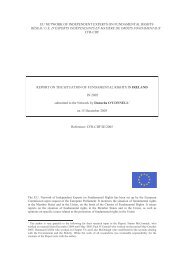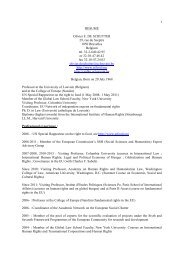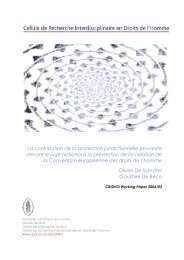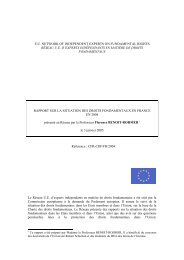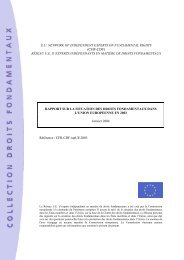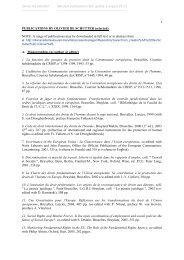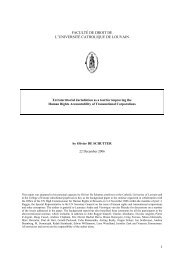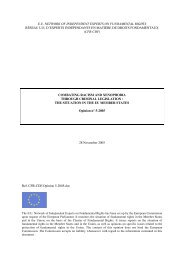The Prohibition of Discrimination under European Human ... - cridho
The Prohibition of Discrimination under European Human ... - cridho
The Prohibition of Discrimination under European Human ... - cridho
Create successful ePaper yourself
Turn your PDF publications into a flip-book with our unique Google optimized e-Paper software.
thematic report<br />
■ THE PROHIBITION OF DISCRIMINATION UNDER EUROPEAN HUMAN RIGHTS LAW ■<br />
complained that a ban on wearing the Islamic headscarf in higher-education institutions violated her rights and<br />
freedoms <strong>under</strong> Articles 8, 9, 10 and 14 <strong>of</strong> the Convention, and Article 2 <strong>of</strong> Protocol No. 1. 134 <strong>The</strong> Court expands here<br />
on the previous case-law <strong>of</strong> the monitoring bodies <strong>of</strong> the ECHR on this topic, which concerns not only the wearing<br />
<strong>of</strong> headscarves by adolescents or by women attending school or higher-level educational institutions, 135 but also<br />
the wearing <strong>of</strong> a headscarf in the context <strong>of</strong> employment : in Dahlab v. Switzerland, 136 the applicant, a primaryschool<br />
teacher in the Swiss canton <strong>of</strong> Geneva, had converted to Islam after that appointment and began wearing<br />
an Islamic headscarf, her stated intention being to observe a precept laid down in the Koran whereby women<br />
were enjoined to draw their veils over themselves in the presence <strong>of</strong> men and male adolescents. This however<br />
appeared to the authorities to be in violation <strong>of</strong> section 6 <strong>of</strong> the Canton <strong>of</strong> Geneva Public Education Act <strong>of</strong> 6<br />
November 1940, which provides that the public education system « shall ensure that the political and religious<br />
beliefs <strong>of</strong> pupils and parents are respected ». After she was formally requested to cease wearing a headscarf when<br />
on duty, Ms Dahlab failed to have that decision annulled by the Swiss courts.<strong>The</strong> <strong>European</strong> Court <strong>of</strong> <strong>Human</strong> Rights<br />
refused to consider that this resulted in a violation <strong>of</strong> Article 9 ECHR, which protects freedom <strong>of</strong> religion. While<br />
acknowledging the difficulty to « assess the impact that a powerful external symbol such as the wearing <strong>of</strong> a<br />
headscarf may have on the freedom <strong>of</strong> conscience and religion <strong>of</strong> very young children », the Court noted that the<br />
applicant’s pupils were aged between four and eight, « an age at which children wonder about many things and<br />
are also more easily influenced than older pupils. In those circumstances, it cannot be denied outright that the<br />
wearing <strong>of</strong> a headscarf might have some kind <strong>of</strong> proselytising effect, seeing that it appears to be imposed on<br />
women by a precept which is laid down in the Koran and which, as the [Swiss] Federal Court noted, is hard to<br />
square with the principle <strong>of</strong> gender equality. It therefore appears difficult to reconcile the wearing <strong>of</strong> an Islamic<br />
headscarf with the message <strong>of</strong> tolerance, respect for others and, above all, equality and non-discrimination that all<br />
teachers in a democratic society must convey to their pupils ».<br />
<strong>The</strong> inadmissibility decision <strong>of</strong> the Court emphasizes « the tender age <strong>of</strong> the children for whom the applicant was<br />
responsible as a representative <strong>of</strong> the State ». It is uncertain to which extent the solution reached in Dahlab, which<br />
is the outcome <strong>of</strong> a delicate weighing <strong>of</strong> all the interests involved, will be transposed to other cases where the<br />
right <strong>of</strong> an employee to manifest his or her religion will conflict with certain interests <strong>of</strong> the employer – or, like in<br />
Dahlab, with the separation between Church and State where public employers are concerned. Even the more<br />
recent judgment in Leyla Sahin does not settle the issue137 . That judgment concerns Turkey, a predominantly<br />
Muslim society in which, therefore, the risk is high that women left « at liberty » to choose whether or not to wear a<br />
headscarf will be pressured by their families or communities to conform to the dominant norms <strong>of</strong> the majority<br />
religion138 . In other contexts, similar across-the-board prohibitions may not be equally acceptable.<br />
134<br />
Eur. Ct. HR (4th sect.), Leyla Sahin v.Turkey (Appl. N° 44774/98) judgment <strong>of</strong> 29 June 2004. See inter alia on this case the commentaries by N.<br />
Chauvin, in Revue française de droit administratif, May-June 2003, pp. 536-54, and by J.-F. Flauss, A.J.D.A., n°5, 2001, pp. 482-484.<br />
135<br />
See Eur. Comm. HR, Karaduman v.Turkey (Appl. no. 16278/90, Commission decision <strong>of</strong> 3 May 1993, DR 74, p. 93; and Eur. Comm. HR, Bulut v.<br />
Turkey (Appl. no. 18783/91, Commission decision <strong>of</strong> 3 May 1993.<br />
136<br />
Appl. no. 42393/98, ECHR 2001-V.<br />
137<br />
Apart from the fact that Leyla Sahin still is not final at the time <strong>of</strong> closing this report.<br />
138<br />
See already, anticipating on the judgment in Leyla Sahin, Eur. Ct. HR (GC), Refah Partisi and Others v.Turkey (Appl. nos 41340/98, 41342/98,<br />
41343/98 and 41344/98), at § 95 :“In a country like Turkey, where the great majority <strong>of</strong> the population belong to a particular religion, measures<br />
taken in universities to prevent certain fundamentalist religious movements from exerting pressure on students who do not practise that<br />
religion or on those who belong to another religion may be justified <strong>under</strong> Article 9 § 2 <strong>of</strong> the Convention” (emphasis added).<br />
48



